Understanding Acoustic Energy in Shockwave Devices
What Is Acoustic Energy and How Does It Apply to Therapy?
Acoustic energy is a form of mechanical energy that travels in waveforms through solid or liquid media. In therapeutic applications, it’s harnessed in the form of pressure pulses—delivered through specially engineered shockwave devices—to stimulate biological tissues without cutting, heating, or causing trauma. When directed at targeted areas of the body, these acoustic waves compress and release tissues rapidly, triggering cellular responses such as regeneration, inflammation modulation, and neovascularization. In aesthetic and rehabilitative use, this translates into pain relief, tissue remodeling, fat breakdown, and improved circulation.
| Energy Type | Nature | Impact on Tissue |
|---|---|---|
| Acoustic energy | Mechanical pressure wave | Stimulates biological response |
| Radiofrequency | Thermal electromagnetic wave | Warms tissue to stimulate collagen |
| Ultrasound | High-frequency soundwave | Micro-vibration for penetration & drug delivery |
Penetration Depth and Wave Focus Explained
Not all acoustic waves penetrate equally. The depth, spread, and power of energy delivery depend on whether the device is generating radial or focused shockwaves. Radial waves disperse energy broadly and are ideal for surface-level applications, while focused waves converge energy deeper into the tissue—up to 12 cm in some models. Knowing how acoustic energy behaves helps practitioners select the right applicator, frequency, and intensity level for each treatment zone. For instance, superficial muscle fatigue may only require radial waves, while calcified tendinitis would benefit from focused penetration.
| Wave Type | Penetration Depth | Best For |
|---|---|---|
| Radial | 0.5 – 3 cm | Muscle fatigue, cellulite |
| Focused | Up to 12 cm | Tendinitis, ED, joint pain |
| Planar | 1–5 cm | Even distribution, fascia work |
Comparing Output and Efficiency Across Devices
Not all shockwave devices deliver acoustic energy equally. High-frequency models like ours integrate TECAR and CET/RET shortwave technology, enabling multimodal therapy for muscle recovery, fat breakdown, and chronic pain relief. The waveform, pulse frequency, and total energy delivered per session all affect treatment outcome and comfort. Practitioners should choose devices with adjustable frequencies, multiple handpieces, and CE or FDA certifications for reliability and safety.
| Device Feature | Standard Unit | KMSLASER Advanced Model |
|---|---|---|
| Energy range | 1–3 bar | 1–5 bar adjustable |
| Pulse frequency | 8–15 Hz | 5–20 Hz high frequency |
| Treatment mode | Single function | Shockwave + TECAR + RET/CET |
Frequently Asked Questions (FAQ)
Q: Does acoustic energy cause any damage to the skin?
A: No. Shockwave devices transmit energy below the skin without damaging the epidermis. The effect is deep and non-thermal.
Q: Is higher energy always better?
A: Not necessarily. The right energy depends on the treatment area and client tolerance. Precision matters more than force.
Q: Can acoustic waves reach bones or tendons?
A: Yes. Focused waves can penetrate deep into joint structures or calcified zones safely and effectively.
Q: How is acoustic energy different from ultrasound?
A: Shockwaves use high-pressure pulses, while ultrasound uses continuous micro-vibrations. Shockwaves trigger regeneration more directly.
Q: Where can I buy a versatile acoustic therapy system?
A: Visit our 3-in-1 device here: shockwave devices for ED, pain relief, and physiotherapy.
Conclusion: The Power of Sound, Engineered for Healing
Acoustic energy in shockwave devices is reshaping how we approach pain relief, recovery, and aesthetic goals. With the right system and settings, practitioners can offer targeted, regenerative care that’s non-invasive, efficient, and deeply effective.
📞 Want to learn more about acoustic energy technology?
Email us at sophia@kmslaser.com or message us on WhatsApp: +86 18676839070





